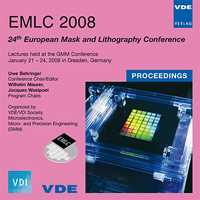Three Dimensional Mask Effects in OPC Process Model Development From First Principles Simulation
Conference: EMLC 2008 - 24th European Mask and Lithography Conference
01/21/2008 - 01/24/2008 at Dresden, Germany
Proceedings: EMLC 2008
Pages: 8Language: englishTyp: PDF
Personal VDE Members are entitled to a 10% discount on this title
Authors:
Melvin III, Lawrence S.; Lia, Jianliang (Synopsys, Inc., 2025 NW Cornelius Pass Road, Hillsboro, OR USA)
Schmoeller, Thomas; Kalus, Christian K. (Synopsys, Karl-Hammerschmidt-Str. 34, Aschheim, Germany)
Abstract:
32 nm half-pitch node processes are rapidly approaching production development, but most tools for this process are currently in early development. This development state means that significant data sets are not yet readily available for OPC development. However, several printing effects are thought to become more prominent at the 32 nm half-pitch node. One of the most significant effects is the three dimensional (3D) mask effect where the mask transmittance and phase are impacted by the mask topography. For the 32nm node it is essential that this effect is correctly captured by the OPC model. As wafer data for the 32nm half-pitch is difficult to obtain, the use of rigorous lithography process simulation has proven to be invaluable in studying this effect. Using rigorous simulation, data for OPC model development has been generated that allows the specific study of 3D mask effect calibration. This study began with Kirchhoff based simulations of 32 nm node features which were calibrated into Hopkin’s based OPC process models. Once the standard Kirchhoff effects were working in the OPC model, 3D mask effects were included for the same data by performing fully rigorous electromagnetic field (EMF) simulations on the mask. New EMF compensation methodologies were developed to approximate 3D mask effects in a fast OPC process simulation. These methodologies modify the phase and transmission of features to compensate for 3D mask effects in a fast OPC model. The OPC model was then refit including the 3D mask effect and found to generate as much as 5 nm differences between the fit Kirchhoff data and the fit 3D mask data. In addition, the Hopkin’s based OPC model with new EMF compensation methodologies has been able to fit the 3D mask data with an RMSE value of 0.52 nm and a range of 2.76 nm. These data were compared to 32 nm half pitch node data from IMEC. In addition the data process models were used for OPC correction with first principles validation to understand the impact of the 3D mask effect on OPC.


